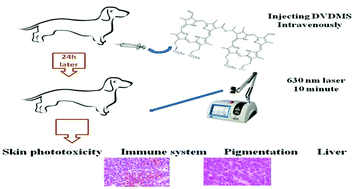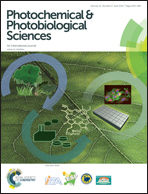A safety study of a novel photosensitizer, sinoporphyrin sodium, for photodynamic therapy in Beagle dogs†
Abstract
Sinoporphyrin sodium (DVDMS) is a novel hematoporphyrin-like photosensitizer developed for photodynamic therapy (PDT), an effective therapeutic modality for tumor treatment; however, the safety of photosensitizer-based PDT is always of great concern. The purpose of the current study was to investigate the potential repeated-dose toxicity and describe the toxicokinetic process of DVDMS-based PDT in Beagle dogs. The dogs were randomly allocated to six groups, and then were administrated a DVDMS preparation intravenously at dose levels of 0, 1, 3, 9, 1 and 9 mg per kg body weight, respectively; then, the latter two groups were illuminated 24 h later with a 630 nm laser for 10 min, once every seven days for 5 weeks. During the study period, clinical signs, mortality, body weight, food consumption, body temperature, ophthalmoscopy, hematology, serum biochemistry, urinalysis, electrocardiograms, toxicokinetics, organ weights, gross anatomy and histopathology were examined. After the administration, no deaths were observed; however, the dogs that received PDT showed skin swelling and ulceration, indicating that DVDMS-PDT induced a phototoxic effect. DVDMS led to an increase in blood coagulation in dogs in the 9 mg kg−1 group and in the two PDT groups on Day 35, whereas it induced a decrease in dogs in the 3 mg kg−1 group and in the two PDT groups on Day 49. The toxicokinetic study showed that the systematic exposure of DVDMS in dogs occurred in a dose-dependent manner, and DVDMS did not accumulate in blood plasma. The DVDMS-based PDT group showed no obvious treatment-related pathological changes; however, slight or mild brown-and-yellow pigmentation of DVDMS (or its metabolite) was observed to deposit in the liver, spleen, local lymph nodes and marrow of dogs in the mid- and high-dose groups, as well as the high-dose PDT group. In females, the absolute and relative spleen weights increased in dogs in the 9 mg kg−1 DVDMS groups with and without PDT during the treatment and recovery period, respectively. The target organs are presumed to be the liver and immune organs (spleen, bone marrow and lymph nodes), while all of the responses were slight. Based on the results above, the no-observed-adverse-effect level (NOAEL) was considered to be 1 mg kg−1, and DVDMS-PDT appeared to be a safe and promising anti-tumor therapy in the clinic.


 Please wait while we load your content...
Please wait while we load your content...